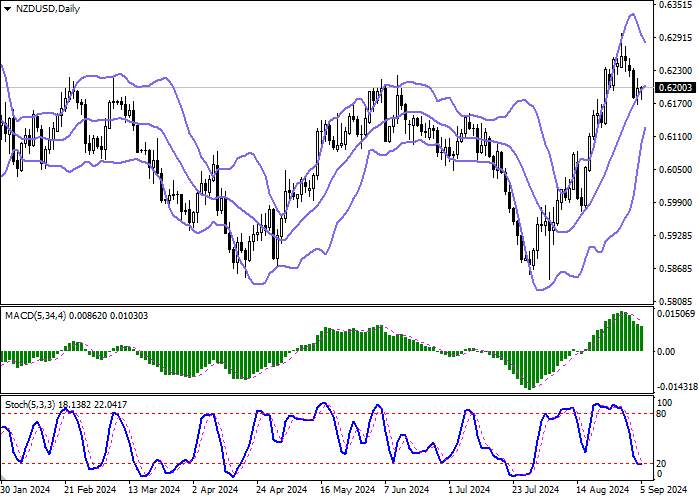Current trend
The NZD/USD pair is showing minor growth, developing the uncertain "bullish" momentum formed the day before, when it managed to retreat from the local lows of August 23. The instrument is testing 0.6200 for a breakout, while market participants are preparing for the publication of data on the US labor market at the end of the week. In particular, today at 14:15 (GMT 2), the August report from Automatic Data Processing (ADP) on the level of employment in the private sector will be presented. The US dollar could be supported if the optimistic forecasts come true and the Employment level in August rises from 122.0 thousand to 145.0 thousand. It will also ease pressure on the US Federal Reserve in terms of adopting a more "dovish" tone at its September meeting.
It should be noted that some analysts still assume that the regulator may decide to reduce the interest rate by 50 basis points at once. The final report on the labor market is expected on Friday, September 6: experts expect that Nonfarm Payrolls will increase in August from 114.0 thousand to 160.0 thousand, Average Hourly Earnings will increase from 0.2% to 0.3% in monthly terms and from 3.6% to 3.7% in annual terms, and the Unemployment Rate will decrease from 4.3% to 4.2%.
Investors turned their attention this week to the Global Dairy Trade Price Index, which makes up a significant portion of New Zealand's exports, which fell 0.4% in August after a strong 5.5% rise the previous month. Markets also reacted to the release of the Australia and New Zealand Banking Group (ANZ) Commodity Price Index, which added 2.1% after falling 1.7%.
Market participants are trying to predict the next steps of the monetary authorities. The Reserve Bank of New Zealand (RBNZ) announced a 25-basis-point cut in borrowing costs slightly earlier than expected, and this led to a change in business and consumer sentiment that expressed confidence in the continued economic recovery. The regulator now predicts that by the middle of next year the interest rate will fall below 4.50%. Centrix data released earlier this week showed mortgage defaults were still 12.0% higher than last year, but the trajectory had changed and households were adjusting their spending as they saw a positive trend in lower borrowing costs. Despite aggressive interest rate increases, New Zealand house prices are only 19.0% below their November 2021 peak, less than half of the more than 40.0% increase during the COVID-19 pandemic.
Support and resistance
Bollinger Bands on the daily chart show a steady increase. The price range is narrowing, being spacious enough for the current activity level in the market. MACD is going down preserving a stable sell signal (located below the signal line). Stochastic, having approached the level of "20", shows a tendency to reverse into the horizontal plane, reacting to the appearance of corrective growth in the middle of the week.
Resistance levels: 0.6200, 0.6221, 0.6254, 0.6300.
Support levels: 0.6177, 0.6153, 0.6130, 0.6100.


Trading tips
Long positions can be opened after a breakout of 0.6221 with the target of 0.6300. Stop-loss — 0.6177. Implementation time: 2-3 days.
The return of a "bearish" trend with the breakdown of 0.6177 may become a signal for new short positions with the target at 0.6130. Stop-loss — 0.6200.





Hot
No comment on record. Start new comment.